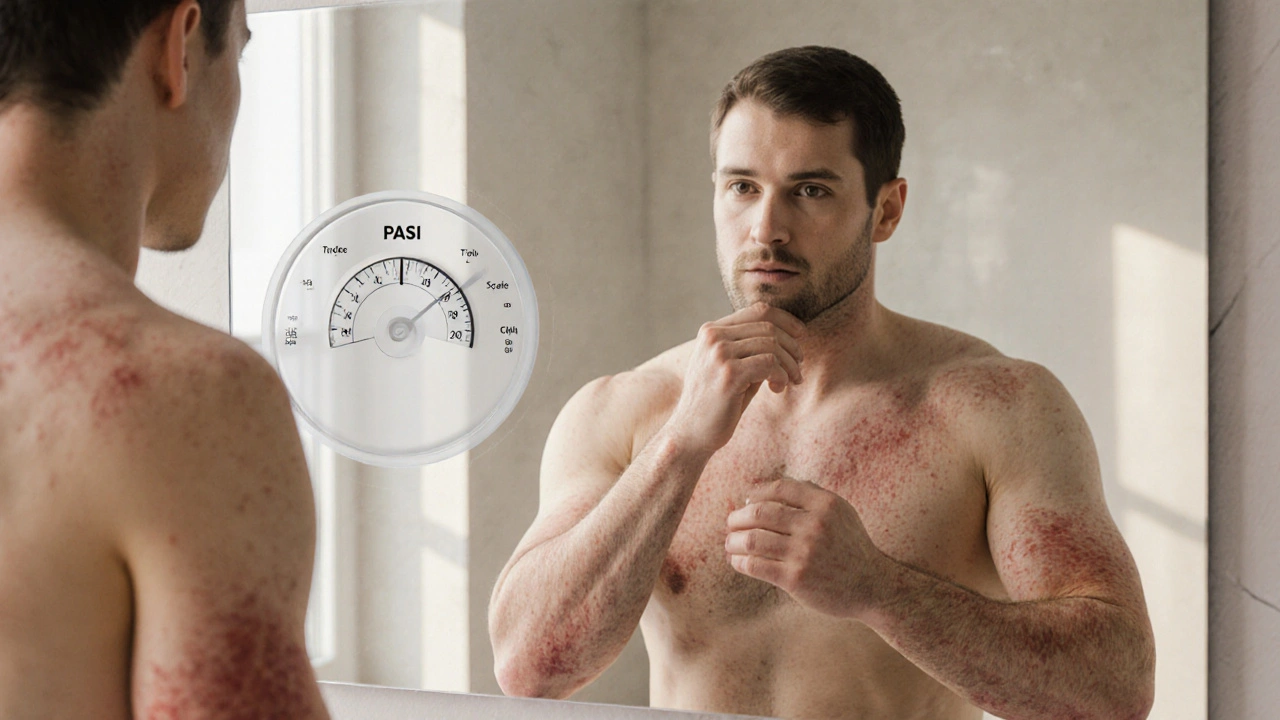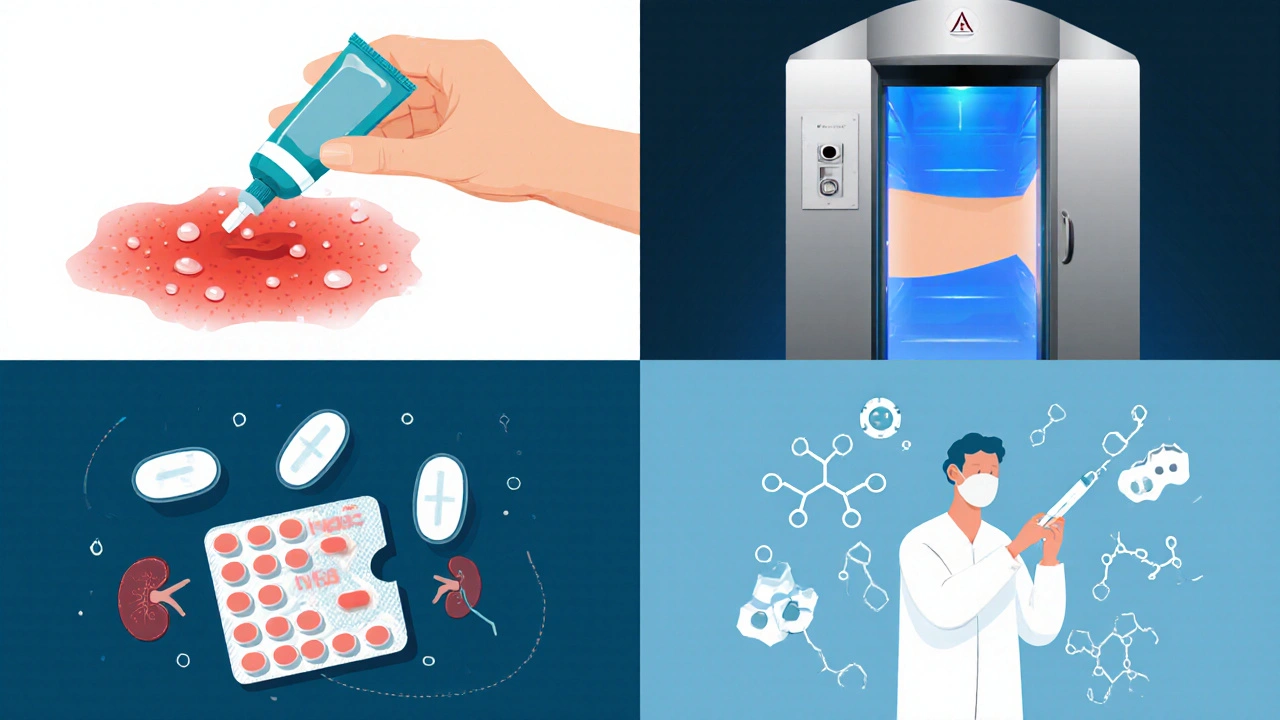Finding the Right Plaque Psoriasis Treatment: A Practical Guide
 Oct, 6 2025
Oct, 6 2025
Plaque Psoriasis Treatment Decision Guide
This interactive guide helps you understand which treatment categories may be appropriate for your plaque psoriasis based on severity and symptoms. It's designed to help start conversations with your dermatologist.
Recommended Treatment Categories
Note: This is an educational tool only. Always consult with your dermatologist to determine the best treatment plan for your individual case.
When it comes to plaque psoriasis treatment, the biggest hurdle is figuring out what actually works for you. Below is a step‑by‑step guide that walks you through the choices, the why’s behind each option, and how to team up with your dermatologist to craft a plan that fits your life.
Understanding Your Condition
Plaque Psoriasis Treatment refers to any medical or lifestyle approach aimed at reducing the red, scaly patches characteristic of plaque psoriasis starts with knowing how severe your skin is affected.
- Psoriasis Area Severity Index (PASI) - a score from 0 to 72 that combines redness, thickness, scaling, and affected area.
- Body Surface Area (BSA) - the percentage of skin covered.
- Patient‑Reported Outcomes - itch, pain, and impact on daily life.
Most clinicians categorize patients as mild (BSA <3% or PASI <5), moderate (BSA 3‑10% or PASI 5‑10), or severe (BSA >10% or PASI >10). Knowing where you land helps narrow the treatment pool.
Major Treatment Categories
Four big groups dominate modern therapy:
- Topical therapies - creams, ointments, gels applied directly to lesions.
- Phototherapy - controlled exposure to UVB or excimer laser light.
- Systemic oral medications - pills that work throughout the body.
- Biologic therapies - injectable or infusion drugs that target specific immune pathways.
Below each category, you’ll see the most common agents and what they’re best at.
Topical Options
Topicals are usually first‑line for mild disease or as add‑ons for moderate disease.
- Topical corticosteroids - reduce inflammation quickly; potency ranges from low (hydrocortisone) to ultra‑high (clobetasol).
- Vitamin D analogues - calcipotriene and calcitriol help normalize skin cell growth.
- Combination products - steroid + vitamin D (e.g., calcipotriene/betamethasone) often give faster clearing.
- Topical retinoids - tazarotene helps with thick plaques but may irritate.
Key considerations: how often you can apply, skin‑type sensitivity, and whether you need a steroid‑sparing strategy for long‑term use.
Phototherapy Basics
When topical creams plateau, UV‑based therapy can jump the response curve.
- UVB broadband - most common, requires 2‑3 sessions per week.
- NB‑UVB (narrowband) - slightly more effective, less risk of burning.
- Excimer laser (308nm) - targets limited spots, useful for stubborn plaques.
Typical course: 12‑20 treatments, then maintenance every few weeks. Benefits include no daily medication and no systemic side‑effects, but you need regular clinic visits and protection from UV‑induced skin aging.

Systemic Oral Medications
Oral drugs kick in when disease spreads beyond the arms and legs.
- Methotrexate - a folate antagonist that curbs rapid skin cell turnover; weekly dosing, monitor liver function.
- Cyclosporine - fast‑acting immunosuppressant; useful for acute flares, but watch blood pressure and kidney health.
- Acitretin - oral retinoid; good for thick plaques, requires strict contraception for up to 3years after stopping.
- Apremilast - PDE‑4 inhibitor; modest efficacy, oral, fewer lab checks.
Choosing an oral agent means weighing speed of relief against long‑term monitoring requirements.
Biologic Therapies
Biologics have transformed severe psoriasis care by zeroing in on specific immune signals.
- TNF‑alpha inhibitors - etanercept, infliximab, adalimumab; work fast, may affect infection risk.
- IL‑12/23 inhibitor - ustekinumab; longer dosing interval (every 12 weeks after start).
- IL‑17 inhibitors - secukinumab, ixekizumab, brodalumab; excellent skin clearance, watch for candidiasis.
- IL‑23 inhibitors - guselkumab, risankizumab, tildrakizumab; high efficacy, low injection frequency.
Biologics are prescription‑only and require insurance pre‑approval in many countries, but they often deliver the highest PASI‑90 rates (90% improvement).
Lifestyle Tweaks that Boost Any Regimen
Even the most potent drug can be undercut by habits that trigger flare‑ups.
- Stress management - mindfulness, yoga, or therapy can lower cortisol‑driven inflammation.
- Smoking cessation - smokers have 2‑3× higher odds of severe disease.
- Alcohol moderation - excessive intake may blunt medication response.
- Skin care basics - gentle, fragrance‑free moisturizers restore barrier function and improve topical absorption.
Guidelines from the National Psoriasis Foundation stress that lifestyle changes are not a substitute for medication but a powerful adjunct.
How to Pick the Right Path for You
Here’s a practical decision‑tree you can run through with your dermatologist:
- Assess severity - mild (BSA <3%)? Start with topicals and moisturizers.
- Check location - scalp or palms/soles often need stronger agents (combination steroid + vit D or a biologic).
- Consider speed of relief - for rapid control, phototherapy or cyclosporine may be chosen before a biologic.
- Review comorbidities - heart disease, liver issues, or infections influence drug safety.
- Discuss logistics - weekly injections vs. monthly clinic visits, insurance coverage, travel ability.
- Set measurable goals - aim for PASI‑75 (75% improvement) within 12weeks, then adjust.
Write down your answers, bring them to the appointment, and ask the dermatologist to map each option to your specific factors.

Comparison of Main Treatment Options
| Category | Typical Use (Severity) | Administration | Common Side Effects | Cost Tier |
|---|---|---|---|---|
| Topical corticosteroids & Vitamin D analogues | Mild‑to‑moderate | Apply 1‑2times daily | Skin thinning, irritation, itching | Low |
| Phototherapy (NB‑UVB, Excimer) | Moderate‑to‑severe | Clinic sessions 2‑3×/week | Redness, premature aging, rare skin cancer risk | Medium |
| Systemic oral meds (Methotrexate, Cyclosporine, Apremilast) | Moderate‑to‑severe | Weekly or daily oral pills | Liver toxicity, hypertension, GI upset | Medium |
| Biologic therapies (TNF‑α, IL‑12/23, IL‑17, IL‑23 inhibitors) | Severe or refractory | Injection or infusion every 2‑12weeks | Infection risk, injection site reaction, rare malignancy | High |
Talking to Your Dermatologist
Preparation can make the appointment far more productive.
- Bring a symptom diary - note flare dates, triggers, and current product usage.
- List all meds, supplements, and over‑the‑counter creams.
- Ask clear questions:
- What is the expected timeline for improvement?
- How will we monitor safety labs?
- What are the backup options if this regimen fails?
- Discuss insurance coverage early - many biologics require step‑therapy approvals.
Remember, you’re a partner in care. The best outcome comes from mutual decision‑making.
Putting It All Together: Your Personal Action Plan
- Rate your current severity using BSA or a quick PASI calculator (many phone apps exist).
- Identify three lifestyle factors you can improve right now (e.g., quit smoking, start a moisturizing routine, schedule stress‑relief activity).
- Match severity to the treatment tier in the table above.
- Schedule a dermatologist visit armed with the checklist from the previous section.
- Set a 12‑week milestone: aim for at least a PASI‑75 response. Re‑evaluate and adjust.
Tracking progress with photos and a simple log helps you see real improvement and justifies insurance decisions.
Frequently Asked Questions
Can I use over‑the‑counter creams alongside prescription meds?
Yes, most OTC moisturizers and barrier creams are safe add‑ons. Avoid combining multiple steroids unless a dermatologist advises, as this can increase skin thinning.
How long does phototherapy usually take to work?
Many patients notice improvement after 6‑8 sessions, with optimal results around 12‑20 treatments. Maintenance sessions keep plaques at bay.
Are biologics safe for people with a history of cancer?
Biologics suppress specific immune pathways, which can slightly raise the risk of certain cancers. Discuss your full medical history with the dermatologist; some agents are preferred for lower oncologic risk.
What lab tests are required for methotrexate?
Baseline liver function, kidney function, and CBC are needed. After starting, repeat labs every 4‑8weeks to catch early toxicity.
Can stress really make my psoriasis worse?
Stress triggers cortisol release, which can amplify the immune response that drives plaques. Mind‑body techniques often reduce flare frequency.

Andrew Miller
October 6, 2025 AT 14:37Man, scrolling through all these treatment options feels like drowning in a sea of jargon. I’m just trying to figure out if I should stick with the creams I know or jump into something more intense. The decision tree looks helpful but also kinda intimidating, especially when you’re already dealing with flare‑ups.
Brent Herr
October 8, 2025 AT 22:10People need to stop treating psoriasis like a lifestyle trend and understand it’s a serious medical condition.
Julius Adebowale
October 11, 2025 AT 05:44Studies show that biologics achieve PASI‑90 in over 70% of patients while topical steroids rarely exceed 30% efficacy.
KISHORE KANKIPATI
October 13, 2025 AT 13:17Wow, the guide really paints a vivid picture of the treatment landscape-like a rainbow of options where each hue represents a different path to relief. From soothing creams that feel like a gentle hug to laser light that zaps away plaques with surgical precision, there’s something for every skin‑battle scenario.
Jefferson Vine
October 15, 2025 AT 20:50Everyone loves to think the pharma giants are just handing out miracles, but did you know most of the “new” biologics were actually engineered from old patents dating back to the 90s? The corporate labs repackage old molecules, add a sprinkle of hype, and then charge us premium prices while the real breakthrough-lifestyle change-gets ignored! It’s a classic distraction.
Ben Wyatt
October 18, 2025 AT 04:24If you’re unsure where to start, try the “step‑up” approach: begin with a high‑potency steroid for a few weeks, add a vitamin D analogue, and monitor your response. Most patients see noticeable improvement within 2‑4 weeks, and you can always discuss adding phototherapy if the plaques persist. Consistency is key, and keeping a diary of flare triggers helps your dermatologist fine‑tune the plan.
Donna Oberg
October 20, 2025 AT 11:57Oh my gosh, thank you sooo much!! 🎉 Your step‑up plan sounds like the perfect roadmap-clear, actionable, and totally doable! I’ve been lost in a maze of creams and pills, and now I finally see a light at the end of the tunnel!!! 🙏❤️
Garreth Collard
October 22, 2025 AT 19:30Honestly, reading this guide felt like being handed the script to a blockbuster movie where the hero (your skin) finally gets the epic comeback scene. The dramatic flare‑ups are the villains, but with the right combo of topicals, phototherapy, and maybe a biologic, you can write your own happy ending. Just don’t forget the supporting cast-moisturizers and stress‑relief techniques.
Daniel LaMontagne
October 25, 2025 AT 03:04Totally vibe with that, Garreth! 😎 The journey can feel like a rollercoaster, but having a solid crew of treatments makes the ride smoother. Plus, a little humor and a good moisturizer never hurt. 🌱👍
Gary Levy
October 27, 2025 AT 10:37I appreciate the balanced overview-especially the reminder that lifestyle tweaks, like stress management and quitting smoking, can boost any medication’s effectiveness. It’s easy to overlook the basics when the high‑tech options look shiny, but they’re the foundation of a sustainable plan.
sourabh kumar
October 29, 2025 AT 18:10True you should not ignore basics they matter a lot
Christian Miller
November 1, 2025 AT 01:44One must consider that the underlying data supporting many of these treatment modalities originates from industry‑funded trials, which may introduce bias into the reported outcomes. Independent meta‑analyses sometimes reveal differing efficacy rates, suggesting patients should critically evaluate the sources of information before committing to a long‑term regimen.
NORMAND TRUDEL-HACHÉ
November 3, 2025 AT 09:17Honestly, the guide is pretty solid, but if you really want to get ahead, look into the newer IL‑23 inhibitors-they’re the real game‑changers these days, even if the hype seems overblown.
AJIT SHARMA
November 5, 2025 AT 16:50What’s the point of all this fancy talk? In my country we just stick to the basics-methotrexate and good old sun exposure. All this “new” stuff is just a way for western pharma to push profit, not real cure.
Neber Laura
November 8, 2025 AT 00:24Data shows that intermittent steroid use can lead to rebound flares if not tapered properly.
Karen Nirupa
November 10, 2025 AT 07:57While the statistics are noteworthy, it is equally important to respect cultural practices that influence treatment adherence. Incorporating traditional skincare rituals alongside prescribed regimens can improve patient satisfaction and outcomes, fostering a more holistic approach.
Quinn Comprosky
November 12, 2025 AT 15:30Choosing a treatment for plaque psoriasis really comes down to personal priorities and how your body reacts to each option. Some people value quick relief above all else and will go for systemic oral medications despite the need for regular lab work. Others prefer to avoid pills and opt for topical creams even if it means a slower improvement. Phototherapy sits in the middle offering decent results without the systemic side effects but requires frequent clinic visits. Biologics provide the highest clearance rates but involve injections and a thorough insurance process. Lifestyle changes such as reducing stress, quitting smoking and limiting alcohol can enhance any of these therapies. Keeping a symptom journal helps you and your dermatologist see patterns and adjust treatment promptly. Moisturizing regularly restores the skin barrier and can make topical treatments more effective. Avoiding harsh soaps and using fragrance free products reduces irritation. It’s also wise to discuss vaccination status before starting immunosuppressive drugs. Patients should ask about possible drug interactions especially if they are on other medications. Regular follow up appointments allow monitoring for side effects and efficacy. Some patients experience a flare when switching between treatments, so a gradual taper is recommended. Education about the disease empowers patients to stick with the plan even when results are not immediate. Ultimately a collaborative approach between you and your healthcare provider yields the best outcomes.
Thomas Ruzzano
November 14, 2025 AT 23:04Honestly the “one‑size‑fits‑all” advice in most guides is garbage – it’s a lazy Western prescription that ignores genetic diversity. If you’re from a region where sunlight is abundant you’d be smarter to harness natural UV rather than pay for overpriced clinic sessions. Stop buying the hype and look for what truly works for your skin.
Dan Tenaguillo Gil
November 17, 2025 AT 06:37It’s great to see such a lively discussion with many perspectives. Remember that each treatment path has its own set of trade‑offs, and the best choice often comes from trial and error under professional guidance. Don’t hesitate to reach out to support groups or patient advocacy organizations-they can provide real‑world experiences and emotional backing. Combining medical therapy with community support often leads to better adherence and outcomes. Keep sharing your journey, as your story might be exactly what someone else needs to hear.